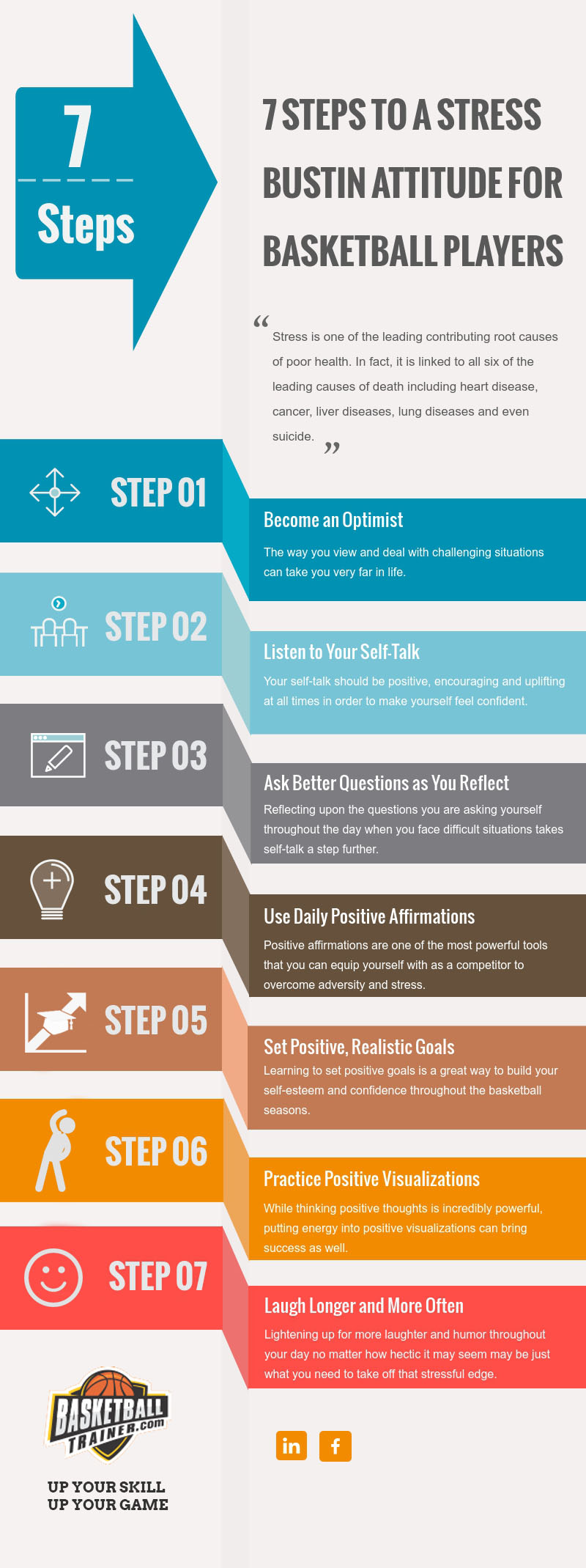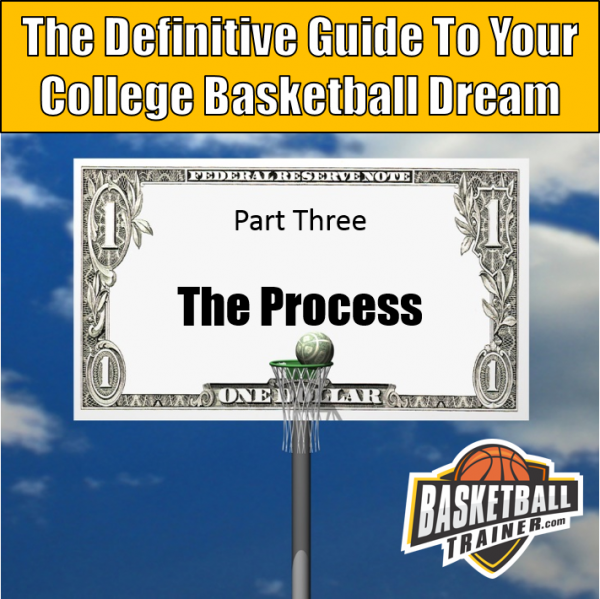
Cutting is a basketball skill that is absolutely critical to individual and team success. The best players are good with and without the basketball. The best passing teams are made up of players who are tremendous cutters.
In this article, we have gathered the 10 most effective basketball cutting drills. These are pro cutting tips and drills for basketball trainers and coaches to use with their players. Players can do many of these drills by themselves or with a teammate or a parent to help.
We will cover:
- Why is cutting important in basketball?
- What makes a good cut in basketball?
- Cutting drills for players and parents
- Best cutting drills for basketball trainers and coaches
Why is cutting important in basketball?
Since there are 5 players on a basketball team, each player will have the ball about 1/5 of the time when they are on offense. That means it is important for players to know how to play during the 80% of the time that they don’t have the ball. Cuttting helps a team in the following ways:
A good cut can get create separation from . You can’t be a good passing team if no one is open to pass to.
The movement that cutters create helps your team maintain spacing (distancing offensive players 15 to 18 feet away from each other). Cutting is how players move away from each other to open up a driving or passing lane for a teammate.

When you are cutting, the player who is guarding you has to focus on staying with you and is less focused to help or trap on the player who has the basketball. If you cut well enough to force a seconder defender to help on you, that creates an opportunity for the player the helping defender is guarding to become open.
No matter what position you play, you will need to be an excellent cutter. It is not only wing players that need to be good cutters. Every player needs to be a good cutter. For example, even if you are a point guard, you need to be a good cutter to get the basketball back once you start the offense. Post players need to have great cutting footwork to establish post position to receive the ball.
What makes a good cut in basketball?
Cutting is not the same as moving. A good cut ends with you “getting open” and away from the defender who is guarding you with room enough to receive a pass. You won’t receive a pass every time you cut and get open. Even when you don’t get the ball when you cut, you are occupying your defender so that they can’t be a help defender and clog driving and passing lanes for your teammates.
 A good basketball cut has the following characteristics:
A good basketball cut has the following characteristics:
- Every great cut starts with an explosive movement.
- Changing pace either from a stationary position to full speed or from a jogging or walking pace to “full go'”
- Changing pace and changing direction getting away from the defensive player
- Always see the basketball when you cut. If your teammate sees that you are open, they are going to pass the ball, so be ready. Nothing is worse than a player who is wide open, but is looking the opposite direction away from the basketball
Here are ten basketball training drills that are a great way to improve your cutting.
Cutting Drills for basketball players and parents
If you want to practice your cutting by yourself, or with a parent, here are some of the most common (but still effective) basketball cuts. The best way to execute these cutting drills is to practice the different types of cuts, one at a time, then use our Curry Drill (described below) to put them all together and practice cutting in a way that is more like a game.
These are not all of the cuts in basketball, but are some that are commonly used. If you are playing for a coach, that coach will have an offensive system that more than likely will require you to learn other types of cuts. We
1 on 1 cuts
Our first series of drills practice the types of cuts to use when you are not receiving a screen from a teammate.

Basket cuts (sometimes referred to as a face cut or front cut). This is the most common cut in basketball. It is also the foundation for one of the most common and effective plays in basketball–the give and go. To run a give and go, pass the ball to teammate and then make an immediate cut to the basket looking for a return pass.
Here is how to execute this cut (see Basket Cut Diagram): Player 1 has the basketball on the left wing (free throw line extended). If you are doing this drill by yourself, set the basketball in the spot where player 1 is on the diagram.
Player 2 will execute a basket cut by taking one slow step in the direction away from the ball and then exploding in front of the defense (x2) and cutting to the basket. As you cut to the basket have your eyes on the ball and your hands ready to catch a pass with both hands and both eyes. If you do have a passer, they will pass you the ball to catch and score without having to dribble.
Repeat this cut 10 times on the left side of the basket and 10 times on the right side of the basket. Make sure to apply our principles for a great cut listed earlier. In case you forgot them, here is a review. If you really want to be a great cutter, you must learn and apply them to all of your cuts.
- Starts with an explosive movement.
- Change pace and change direction when you cut.
- The goal for your cut is to get away from the defense.
- Look at the ball when you cut
When you make a basket cut, you want to cut in front of your defender to block them from stealing a pass thrown to you.
Backdoor cut: (aka back cut)
You will use this cut when the player guarding you is overplaying you and playing denial defense so that you can’t catch a pass. They will either have their arm or their entire body in the passing lane between you and your teammate who has the ball.
To execute a backdoor cut, take one step toward the player with the basketball to get the defense moving away from the direction that you want to cut. Then make a quick and explosive step toward the basket. A bounce pass is often the best pass to throw to a backdoor cutter, so make sure that you are looking for a bounce pass.
The backdoor cut has to be timed correctly to work. When you cut, the player with the ball will throw the pass in front of you so that you can catch it in stride and shoot a layup. If you fake like you are going to cut backdoor and then stop, you will not only fake out the defense, but you will also fake out the passer which will result in a turnover. If you start to cut back door, keep going. If your aren’t open, your teammate can see that and won’t throw the pass.
Most backdoor cuts come from the deep corner, or the wing (that is the free throw line extended), or from the top of the key area. That is where you will practice cutting from.
Here are 4 backdoor cuts to practice at a game pace.
If you do have a teammate or parent who can pass to you, that is even better because you can practice catching and scoring. If you don’t have someone to pass to you, you can still practice the cut.
As in the previous diagram, the dashed line is the basketball being passed if you are practicing with a passer.

Backdoor Cut from Slot
- Put a basketball at the right slot. That is the spot on the court just past the three point arc and even with the free throw lane. In the Backdoor cut from slot diagram, player #1 is holding the basketball at the right slot (indicated by the circle around player 1).Start at the right wing (noted by the location of player 2 in the diagram. Step toward the ball. That will force your defender to move toward the basketball as well. Then, plant and push off that foot and sprint to the basket–all the time looking at the basketball. Repeat 10 times.Each time use your imagination to see yourself catching the backdoor pass and laying the ball in the basket.
- Move the basketball to the left slot (3 on Backdoor Cut from Slot Diagram) and make 10 backdoor cuts from the left wing (4 on Backdoor Cut from Slot Diagram). Always look for the ball when you cut.

Backdoor Cut from Deep Corner
Backdoor Cut from Deep Corner
- Put the basketball on the right wing (player #1 in the Backdoor Cut from the Deep Corner Diagram) and make 10 backdoor cuts from the right deep corner. Again, step to the basketball first to drive your defender away from the direction that you will be cutting.
- Move the ball to the left wing (spot #3 Backdoor Cut from the Deep Corner Digram) and make 10 back cuts from the left deep corner (Spot #4 on the same diagram).
Fill Cut

The purpose of a fill cut is to get open at the top of the key, or in the left or righ slot to reverse the side of the basketball court that the ball is on. That means pass the ball from one side of the floor to the top, and then from the top to the opposite side.
To make a fill cut, (see fill cut diagram) #4 will walk her defender into the lane at a walking pace and then explode until she get the slot.
If #4 doesn’t fill cut, then #5 can fill the slot by making a straight cut up to the slot.
To practice fill cuts, make 10 fill cuts from one side of the floor and then 10 on the other side of the floor. Each time you finish your cut in the slot, pretend that you are catching an imaginary pass from one side of the floor, look at the basket to look for an imaginary cutting or open teammate, and then make an imaginary pass to the opposite side of the floor.
Now we will focus on some cuts you make will need to be able to make when a teammate sets a screen for you.
Teaching point: If you are using a teammate’s screen, you need to be close enough to them that you can rub your shoulder against their shoulder. That makes it very difficult for the player guarding you to get through the screen.
Here are 4 types of cuts that you can make when a teammate sets a downscreen for you.
Just as you have before, you will do each of these cuts 10 times on both sides of the floor.
When you receive a downscreen from a teammate, the type of cut you use depends on how the defender plays you. It takes practice to recognize what the defense is doing.
When a teammate sets a down screen for you, you can make one of the following cuts:

Curl Cut Diagram
Curl cut: This is the most effective cut when your teammate sets a downscreen for you and the defense is behind you or trailing you. See the Curl Cut Diagram.
The cutting player explodes into the cut and circles around the teammate who is setting the screen. As the cutter, it is important to physically touch your teammate who is setting the screen for you.

Straight Cut Diagram
Straight cut: If the defense stays close to the basket and keeps you from making a curl cut. Cut straight to the basketball, but stop 15 feet away from the player with the ball. That allows you to maintain good offensive spacing. Offensive spacing is the distance between two offensive players.
Fade cut: If the defensive player positions themseleves that you can’t make a curl cut or a straight cut, cut to the corner. This is known as a fade cut.

Fade Cut Diagram
It is the least effective cut to score on because the player with the basketball will have to make a long pass to get the basketball to you. But, it does help your team by you spacing to the corner to open up the middle of the floor.
Backdoor Cut: If the defense jumps into the passing lane to look to steal the basketball, make a backdoor cut to the basket.
Curry Cutting Drill
In a game, you will usually make a series of different cuts each time your team has the ball. This drill is designed to put many types of cuts together.
Steph Curry is great when he has the ball, and he is equally as skilled at cutting to get open.
To execute this drill, place a basketball somewhere on the court approximately 3 feet behind the three point arc. You will start underneath the net. Imagine that you have the best defensive player you know guarding you. If you can’t think of anyone, pretend that Marcus Smart or A’ja Wilson are guarding you. They were the 2022 NBA and WNBA Defensive Player of the Year Award Winners.
You are going to execute the cuts diagrammed and discussed above for 30 seconds. It is very important to think about which cut your are doing so that you are making basketball cuts and not just running around like someone whose pants are on fire! 🙂 That means that the first few times that you do this drill, you will need to go at a slow pace to think about your cuts. The more times you do the drill, the quicker pace you can go at.
Start under the rim and pretend there is a defensive player guarding you. Pretend that you are receiving a downscreen from a teammate. Walk your defender in the opposite direction from where you plan to cut, and make one of the four cuts (curl, straight, fade, back) off the downscreen. From there, mix up the cuts that you have practice one at a time. Make some
Best cutting drills for basketball trainers and coaches
These drills are designed to improve cutting, but they also have the added benefits of helping passers get better at passing to a cutting player.
Some of our drills involve the offense not being allowed to dribble. That is to place the emphasis on cutting to get open to catch a pass. For younger or beginning players, you can allow a single dribble each time a player catches the ball to get away from their defender and make the pass shorter.
4 on 4–no dribble game.
The best cutting drill in basketball is to play 4 on 4 and not allow the offense to dribble. I know you are probably thinking, “How can you play basketball and not dribble?” Well the answer is, you can, but it is VERY HARD and practing this way is going to make players much better cutters!
If the player with the ball has only 2 options–shoot or pass, her teammates have to execute excellent cuts to get open to receive the ball. Playing this game for 5 minutes gives every player a lot of practice cutting. If all players follow the cutting techniques we just described, they will become excellent cutters in just a few times of playing this game.
To play the drill, simply play normal basketball rules plus one special rule. If the offensive team dribbles, it is a turnover and the other team receives possession of the basketball. Start a player at the top of they key with the ball. The other offensive players can start anywhere in the half court. Each of the other three offensive players makes the cuts described above to get open to receive a pass and play until one team scores 10 points. Just like a game, score by 1 for free throws made, 2 for layups or a jump shot made inside the arc, and 3 for a three point shot made.
The first few times you run this cut drill, you might want to play until a team scores 5 points until you get the hang of it.
You need a team to run this drill. If you don’t have 8 players, you can play 3 on 3 No Dribble, or 2 on 2 No Dribble. If there are only 2 players available, you can play…
Off the ball one one one
This is a one one one drill. You do need two players and three basketballs, Put a chair on the right wing, another chair on the left wing, and a chair at the top of the key. Put a basketball on the seat of each chair. Players start in the three second lane. Designate who the player is on offense and who the player is on defense.
The first player should walk the defense away from where they want to cut and make an explosive change of directions to get to one of the chairs to pick up the basketball. From there, it is one on one–player with the ball works to get to the basket, or get a shot off the dribble.
You don’t put the ball back on the chair until the offensive player scores, or the defensive player gets a steal or a rebound. In summary, instead of “checking it up” after each change of possession, you start with the offensive player cutting from the lane to one of the basketballs.
A few teaching points to run this drill.
- The better cut the offensive player makes to create separation between them and the defense, the better shot they can get after picking up the ball.
- Think of it as a race to one of the basketballs. Did you ever hold races with your friends? What was the advantage in those races? The advantage was being the one who shouted “GO!” You knew when you were going to say go, but your friend you were racing against didn’t. It’s the same principle with cutting if you can slowly walk the defense towards one chair with a basketball and then change directions quickly to go to a different one, they don’t know when you are telling yourself “GO!” That gives the cutter an advantage.
- Fake a cut to make a cut. Walk the defensive player away from the direction you want to cut. If they don’t react with you, then just make a straight cut to that basketball.
- In basketball, you are the most open when you first catch the basketball. After that, the defense will recover to you. Work on that in this drill and if you can create separation from the defense, look for a quick shot, or a drive if the defense is off balance when they catch up to you.
- If you don’t have access to folding chairs, just put the basketballs on the ground at the spots mentioned. The offensive player will bend over to pick one up which isn’t ideal, but it will work.
Odd Man (or Woman) Out
If you have 3, 5, 7, or 9 players to run a cutting drill designate one player as the permanent passer.
Here is how the drill is run with five players. You will play 2 on 2 no dribble as described earlier. The permanent passer will play with the each team when they are on offense. One team starts on offense. The other on defense.
The permanent passer starts with the basketball. The two players on the offensive team cut to get open. The permanent passer passes to either one who gets open, then goes and screens for the other player who did not receive the pass. This gives the players a chance to practice cuts coming off a screen.
Since the permanent passer is not guarded, they can always cut to be in a position to catch a pass. When an offensive player does pass to the permanent passer, she should either make a basket cut, or go screen for her teammate. The permanent passer should practice good fundamentals like using pass fakes and maintaining triple-threat position.
If the permanent passes makes a turnover pass, the same team keeps the ball. That way the permanent passer does not cost them to lose the ball to the other team. Play to 8 by normal basketball scoring rules and then get a new permanent passer and start a new game to 8.
20 Point Game
This game can be played is best played 3 on 3 or 4 on 4, but will also work 5 on 5 or 2 on 2. Because we want to emphasize cutting in this dril, there is no dribbling. The offense scores one point for each pass they complete in addition to any baskets they score. In addition to forcing the offense to make good cuts, the defense is able to work on their pressure defense.
The first team with the ball has an advantage in this game. To see which team gets the ball first, alternate free throws. First team that misses a free throw starts on defense.
There you have 4 very good drills to improving your cutting. These drills force you to cut at game speed and against real defensive players. If you are working on cutting by yourself, you have to use a little more imagination. And, you have to be willing to push yourself.

 Pasture-Raised Eggs
Pasture-Raised Eggs Organic
Organic  Organic Spinach / Organic Broccoli
Organic Spinach / Organic Broccoli Organic Sweet Potatoes
Organic Sweet Potatoes Wild-Caught Salmon
Wild-Caught Salmon
 Avocados
Avocados Sourdough Bread
Sourdough Bread Grass-Fed/Finished Beef
Grass-Fed/Finished Beef Full-Fat Cheese from
Full-Fat Cheese from Organic Cauliflower
Organic Cauliflower Organic
Organic  Organic Beans
Organic Beans Organic Chicken
Organic Chicken Organic
Organic  Full-Fat
Full-Fat
 Wild-Caught Tuna
Wild-Caught Tuna Protein
Protein  Cod Liver Oil (Supplement)
Cod Liver Oil (Supplement)

 Rusty Gregory, MS, CSCS
Rusty Gregory, MS, CSCS








 As you go throughout your day you will notice that you are always talking to yourself. Sometimes what you are saying is positive and sometimes it’s negative. By beginning to pay closer attention to the way you are talking to yourself you can gain a great idea of why you tend be more positive or negative in general. Your
As you go throughout your day you will notice that you are always talking to yourself. Sometimes what you are saying is positive and sometimes it’s negative. By beginning to pay closer attention to the way you are talking to yourself you can gain a great idea of why you tend be more positive or negative in general. Your  Reflecting upon the questions you are asking yourself throughout the day when you face difficult situations takes self-talk a step further. It’s easy to fall into a negative, stress inducing pattern of beating ourselves up with self-defeating questions like, “Why do I always miss my second free throw?” or “Why do I always have to mess up that play?” Instead, ask yourself questions that are going to help you overcome the situation or circumstance like “What do I need to learn from my failed attempts to make it better the next time?” or “How can I adjust my form and visualize my shots going in so that I can improve my free throw percentage?” These are the kinds of questions that are focused on the positive and are going to get you much better results.
Reflecting upon the questions you are asking yourself throughout the day when you face difficult situations takes self-talk a step further. It’s easy to fall into a negative, stress inducing pattern of beating ourselves up with self-defeating questions like, “Why do I always miss my second free throw?” or “Why do I always have to mess up that play?” Instead, ask yourself questions that are going to help you overcome the situation or circumstance like “What do I need to learn from my failed attempts to make it better the next time?” or “How can I adjust my form and visualize my shots going in so that I can improve my free throw percentage?” These are the kinds of questions that are focused on the positive and are going to get you much better results. Positive affirmations are one of the most powerful tools that you can equip yourself with as a competitor to overcome adversity and stress. Affirmations are things that we believe and they become imprinted on our subconscious mind, so regardless of whether you are consciously thinking a positive or negative thought at the time, what your subconscious believes is typically how you will behave when you are faced with stress. For example, if you believe that you are not a
Positive affirmations are one of the most powerful tools that you can equip yourself with as a competitor to overcome adversity and stress. Affirmations are things that we believe and they become imprinted on our subconscious mind, so regardless of whether you are consciously thinking a positive or negative thought at the time, what your subconscious believes is typically how you will behave when you are faced with stress. For example, if you believe that you are not a  Learning to set positive goals is a great way to
Learning to set positive goals is a great way to  While thinking positive thoughts is incredibly powerful, putting energy into positive visualizations can bring success as well. How about picturing yourself hitting the game winning shot before you even take it, or how about seeing yourself shutting down the other teams’ best player? If you can create visualization in your
While thinking positive thoughts is incredibly powerful, putting energy into positive visualizations can bring success as well. How about picturing yourself hitting the game winning shot before you even take it, or how about seeing yourself shutting down the other teams’ best player? If you can create visualization in your  Lightening up for more laughter and humor throughout your day no matter how hectic it may seem may be just what you need to take off that stressful edge. In fact, making time to laugh often is the most powerful stress-buster around. Research and studies are also now showing that laughing has the potential to boost the immune system as well considering that stress levels and immunity do go hand-in-hand.
Lightening up for more laughter and humor throughout your day no matter how hectic it may seem may be just what you need to take off that stressful edge. In fact, making time to laugh often is the most powerful stress-buster around. Research and studies are also now showing that laughing has the potential to boost the immune system as well considering that stress levels and immunity do go hand-in-hand.








 In an effort to gain more exposure prospects will often attend showcase events run by a variety of different organizations in the summer, fall and spring. Showcase events also occur during the high school season when organizers look to schedule multiple games pitting non-conference opponents against each other in a day-long, weekend or a holiday setting drawing recruiters while they look to cash in on sponsors, fans, concessions and merchandise. Showcases are very often attended by college, prep and junior college coaches from all levels and give kids a chance to really make a great impression. However, prospects can also often leave these events overwhelmed, intimidated and under the radar with such an influx of talent all at one location in a condensed time setting. Various factors including politicking by high school and all-star coaches as well as parents and even the showcase promoters cause a high percentage of quality prospects to miss out. These events have become platforms for grassroots organizers to promote their product while putting on a great show which showcases individualized play.
In an effort to gain more exposure prospects will often attend showcase events run by a variety of different organizations in the summer, fall and spring. Showcase events also occur during the high school season when organizers look to schedule multiple games pitting non-conference opponents against each other in a day-long, weekend or a holiday setting drawing recruiters while they look to cash in on sponsors, fans, concessions and merchandise. Showcases are very often attended by college, prep and junior college coaches from all levels and give kids a chance to really make a great impression. However, prospects can also often leave these events overwhelmed, intimidated and under the radar with such an influx of talent all at one location in a condensed time setting. Various factors including politicking by high school and all-star coaches as well as parents and even the showcase promoters cause a high percentage of quality prospects to miss out. These events have become platforms for grassroots organizers to promote their product while putting on a great show which showcases individualized play.  New York City is known as a breeding ground for point guards. Nate Archibald (Bronx), Mark Jackson (Brooklyn), Earl “The Pearl” Washington (Brooklyn), Bob Cousy (Cambria Heights), Sebastian Telfair (Brooklyn) and Kenny Anderson (Queens) to name just a few have given the world of basketball some of the best pure point guards ever seen.[2] On the flip side of the city life, there are the Larry Bird-prospects that rise to the NBA from rural small towns in underpopulated remote areas. The
New York City is known as a breeding ground for point guards. Nate Archibald (Bronx), Mark Jackson (Brooklyn), Earl “The Pearl” Washington (Brooklyn), Bob Cousy (Cambria Heights), Sebastian Telfair (Brooklyn) and Kenny Anderson (Queens) to name just a few have given the world of basketball some of the best pure point guards ever seen.[2] On the flip side of the city life, there are the Larry Bird-prospects that rise to the NBA from rural small towns in underpopulated remote areas. The 
 The NCAA also require SAT or ACT minimum “sliding scale” scores for admissions. The sliding scale is in place to give students flexibility in regards to their low GPA or test scores.[10] To qualify to play intercollegiate athletics at the NAIA level, students must meet two out of the following three requirements; a minimum of 18 on the ACT or 860 on the SAT (Critical Reading and Match only), earn an overall high school GPA of 2.0 on a 4.0 scale and/or graduate in the top 50% of their graduating class.[11] The NAIA offers the two out of three instead of the NCAA sliding scale test score method but both have the same purpose, give lower academic students some flexibility to become eligible. Passing through NCAA and/or NAIA Eligibility Center does not guarantee admission into a given school. The final decision for acceptance to a school and the completion of The Process lies in the hands of the admissions department at each respective institution.
The NCAA also require SAT or ACT minimum “sliding scale” scores for admissions. The sliding scale is in place to give students flexibility in regards to their low GPA or test scores.[10] To qualify to play intercollegiate athletics at the NAIA level, students must meet two out of the following three requirements; a minimum of 18 on the ACT or 860 on the SAT (Critical Reading and Match only), earn an overall high school GPA of 2.0 on a 4.0 scale and/or graduate in the top 50% of their graduating class.[11] The NAIA offers the two out of three instead of the NCAA sliding scale test score method but both have the same purpose, give lower academic students some flexibility to become eligible. Passing through NCAA and/or NAIA Eligibility Center does not guarantee admission into a given school. The final decision for acceptance to a school and the completion of The Process lies in the hands of the admissions department at each respective institution. A typical admissions checklist for a college or university will include an application ($40 fee), official high school transcripts, letter of recommendation and a brief essay. Admissions departments will also encourage a campus visit and once they have the prospective student touring their grounds, they will conduct an interview. More and more schools have moved to the on-line approach of recruiting which enables them to attract and filter through large numbers of recruits without physically having them on-campus. While college coaches are targeting student-athletes for their teams as early as middle schools, the admissions process typically begins junior year in high school when students, guidance counselors along with parents and or guardians will target schools and map out some possible campus visits. Some highly regarded academic high schools have students begin this process their sophomore year but generally some prep work and “feeling out” is done junior year and The Process really takes flight senior year. Students will prepare essays (1-2 pages), gather letters of recommendation (usually 1 or 2 from a teach, guidance counselor or other school official) and official transcripts (complete with grades, class rank and test scores) while deciding which colleges they would like to apply to and figure out if they want to go for early or general admissions to the chosen institution(s).[12] Once application files are complete, schools make a decision and put the ball in the court of the recruit.
A typical admissions checklist for a college or university will include an application ($40 fee), official high school transcripts, letter of recommendation and a brief essay. Admissions departments will also encourage a campus visit and once they have the prospective student touring their grounds, they will conduct an interview. More and more schools have moved to the on-line approach of recruiting which enables them to attract and filter through large numbers of recruits without physically having them on-campus. While college coaches are targeting student-athletes for their teams as early as middle schools, the admissions process typically begins junior year in high school when students, guidance counselors along with parents and or guardians will target schools and map out some possible campus visits. Some highly regarded academic high schools have students begin this process their sophomore year but generally some prep work and “feeling out” is done junior year and The Process really takes flight senior year. Students will prepare essays (1-2 pages), gather letters of recommendation (usually 1 or 2 from a teach, guidance counselor or other school official) and official transcripts (complete with grades, class rank and test scores) while deciding which colleges they would like to apply to and figure out if they want to go for early or general admissions to the chosen institution(s).[12] Once application files are complete, schools make a decision and put the ball in the court of the recruit. Financial planning and financial aid are often a deal breaker in the recruits’ decision to where they go to school. While the hope is that students will be able to afford college with a full-ride athletic scholarship (Part 1) or some sort of family trust, nest egg or a big dip into savings, the reality is that two thirds[13] of all students take advantage of academic merit scholarships, athletic scholarships and/or FAFSA as discussed in Part 2 (link or even excerpt here). Students can apply for FAFSA beginning on January 1 of their senior year in high school. Early application is encouraged as much of the funds are awarded first come, first serve once the need is determined to be equal. The Process for the ‘average’
Financial planning and financial aid are often a deal breaker in the recruits’ decision to where they go to school. While the hope is that students will be able to afford college with a full-ride athletic scholarship (Part 1) or some sort of family trust, nest egg or a big dip into savings, the reality is that two thirds[13] of all students take advantage of academic merit scholarships, athletic scholarships and/or FAFSA as discussed in Part 2 (link or even excerpt here). Students can apply for FAFSA beginning on January 1 of their senior year in high school. Early application is encouraged as much of the funds are awarded first come, first serve once the need is determined to be equal. The Process for the ‘average’  Put quite simply, the more a coach wants a player, the more attention he or she is going to get during The Process. However, recruits should never stop trying to prove themselves and should not settle for a team because it is local, or their sibling or friend is there or because they are being pushed there by a community, parents, high school coach or some other outside influence. If you are looking to get a start in narrowing down college choices that might be a fit for you, then I recommend you use a tool developed by a company I am involved with. The Sport Source has a tool that is free for 24 hours use that permits you to input some of your criteria and also qualifications and then helps create a personalized database of which schools could be a fit for you.
Put quite simply, the more a coach wants a player, the more attention he or she is going to get during The Process. However, recruits should never stop trying to prove themselves and should not settle for a team because it is local, or their sibling or friend is there or because they are being pushed there by a community, parents, high school coach or some other outside influence. If you are looking to get a start in narrowing down college choices that might be a fit for you, then I recommend you use a tool developed by a company I am involved with. The Sport Source has a tool that is free for 24 hours use that permits you to input some of your criteria and also qualifications and then helps create a personalized database of which schools could be a fit for you. 



 Big men, the game has changed for you. Twenty years ago you were relied on more heavily for offense and because of that were more celebrated by the viewing public. However coaches and basketball people still know how important you are to basketball teams. We still love you and value the things that you do. You are the defensive anchor, rim protector and possession finisher that teams still need to win games. And you can still be effective in today’s more perimeter oriented offensive attacks.
Big men, the game has changed for you. Twenty years ago you were relied on more heavily for offense and because of that were more celebrated by the viewing public. However coaches and basketball people still know how important you are to basketball teams. We still love you and value the things that you do. You are the defensive anchor, rim protector and possession finisher that teams still need to win games. And you can still be effective in today’s more perimeter oriented offensive attacks.




